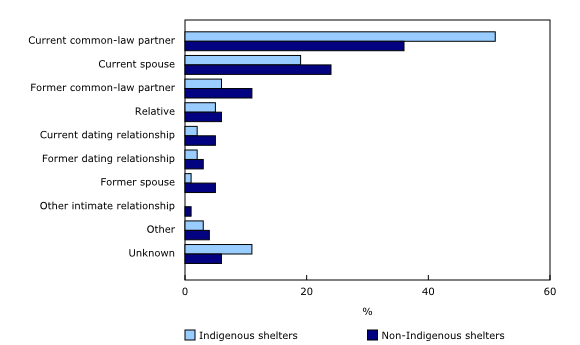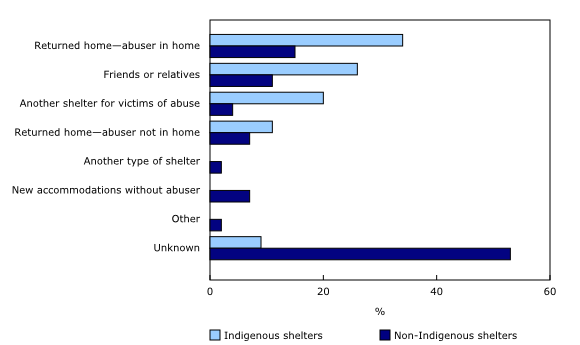Study: Shelters for victims of abuse with ties to Indigenous communities or organizations in Canada, 2017/2018
Archived Content
Information identified as archived is provided for reference, research or recordkeeping purposes. It is not subject to the Government of Canada Web Standards and has not been altered or updated since it was archived. Please "contact us" to request a format other than those available.
Released: 2020-07-22
There were 85 shelters for victims of abuse that had ties to First Nations, Métis or Inuit communities or organizations operating across Canada in 2017/2018. These Indigenous shelters, which are primarily mandated to serve victims of abuse, play an important role for victims leaving abusive situations by providing a safe environment and basic living needs, as well as different kinds of support and outreach services. Over a one-year period, there were more than 10,500 admissions to Indigenous shelters; the vast majority of these admissions were women (63.7%) and their accompanying children (36.1%).
Violence in the home has been raised as a major concern by health and safety authorities during the COVID-19 pandemic. Women and children victims of abuse are among some of the most vulnerable populations, who are often living with their abusers with little possibility of escape.
A Juristat article that focuses on the characteristics of Indigenous shelters for victims of abuse and their residents in 2017/2018 is now available. The article details the types of abuse that victims reported to the shelters and their reasons for seeking shelter. The article, "Shelters for victims of abuse with ties to Indigenous communities or organizations in Canada, 2017/2018," uses data from the Survey of Residential Facilities for Victims of Abuse (SRFVA). The SRFVA collected both annual data (2017/2018) and data from a single survey day (April 18, 2018) from all shelters for victims of abuse in Canada.
While these data are from prior to the COVID-19 pandemic, they provide valuable insight into shelter use in Canada and the challenges that shelters and victims of abuse were facing in 2017/2018. Recent information released by Statistics Canada has shown that violence in the home is a concern among Canadians while living in the context of the COVID-19 pandemic. These unprecedented times are likely to have a considerable impact on victims needing to seek shelter and access victim services, as well as shelters needing to adapt their services. The next iteration of the SRFVA will highlight the effect of the COVID-19 pandemic on shelters—allowing for a more comprehensive understanding of the impact of the pandemic on shelter use and victims of abuse.
Most residents seek shelter due to abuse by a current or former intimate partner
On the survey day of April 18, 2018, there were 344 women and 288 children residing in Indigenous facilities who reported abuse as their primary reason for seeking shelter. Around 70% of women and children in Indigenous shelters, and around 20% of women and children in non-Indigenous shelters, identified as First Nations, Métis or Inuit.
The majority of the women in Indigenous shelters identified a current (72%) or former (9%) intimate partner as the abuser. Most women experienced multiple types of abuse, with the most commonly-reported types being emotional or psychological abuse (86%) and physical abuse (74%). While slightly smaller proportions of women in non-Indigenous shelters also experienced abuse by a current intimate partner (65%), a greater proportion of women in non-Indigenous shelters experienced abuse by a former intimate partner (19%).
One in three women leaving an Indigenous shelter return to live with the abuser
Shelters for victims of abuse offer a temporary place for individuals to leave abusive situations. If other types of support are not available, victims may end up returning to live with the abuser. On the survey day, of the women who left an Indigenous shelter, one-third (34%) said that they were returning to a home with the abuser. Just over one-quarter (26%) of the women were going to live with friends or relatives, while 20% were departing for another shelter for victims of abuse. A further 11% of women were returning to a home where the abuser would no longer be living.
Three-quarters of the beds at short-term Indigenous shelters were occupied on the survey day
On April 18, 2018, there were 962 funded beds in the 79 short-term Indigenous shelters for victims of abuse. These facilities reported that three-quarters (75%) of their funded beds were occupied on the survey day. Overall, one-third (34%) of all short-term Indigenous shelters were considered full (that is, 90% occupancy or greater) on the survey day.
Indigenous and non-Indigenous shelters were experiencing very similar situations on that day in 2018, such as having to turn away women because they were occupied at maximum capacity. This was the most common reason why a woman was turned away from both Indigenous (56%) and non-Indigenous (84%) shelters.
Other common reasons for turning women away from Indigenous shelters included safety issues (9%) (for example, the individual was on a non-admit or caution list), transportation issues (7%), or a lack of resources for addressing substance use issues (7%).
A lack of permanent housing is the most common challenge for Indigenous shelters
In addition to issues with capacity and high occupancy, shelters for victims of abuse face many other challenges, including issues related to their operation, their residents, and the services they provide. All of these issues are likely to be major challenges during the pandemic.
In 2017/2018, Indigenous shelters listed a lack of permanent housing for their residents (48%) as the most common challenge they faced. Along the same lines, both Indigenous and non-Indigenous shelters indicated the biggest challenge that their residents faced in 2017/2018 was a lack of affordable long-term housing (70% and 79%, respectively).
Notably, housing shortages can result in victims remaining in or returning to abusive situations because they have nowhere else to go. Many residents also end up staying in short-term shelters for longer than three months, the expected maximum stay, when there are no suitable housing alternatives available to them. This can place additional strain on the existing shelters. In 2017/2018, 16% of short-term Indigenous shelters and 18% of short-term non-Indigenous shelters reported average lengths of stay that exceeded three months.
Note to readers
This Juristat article uses data from the Survey of Residential Facilities for Victims of Abuse (SRFVA). The SRFVA is a census of all shelters in Canada that are primarily mandated to serve victims of abuse. The SRFVA collected annual (2017/2018 fiscal year) and survey day (April 18, 2018) information from shelters.
The April 18, 2018 reference period reflects the survey day, a predetermined business day meant to represent a typical day of operations for shelters across Canada.
Shelters were asked to report the type of facility they operated based on the expected length of stay provided in their service mandate, regardless of practice. They were grouped into two categories:
- Short-term shelters include those with a general policy of providing accommodation for less than three months and typically provide individual beds to residents.
- Long-term shelters include those with a general policy of providing accommodation for three months or more and typically provide residential units (such as apartments or houses) to residents.
The SRFVA asks responding shelters five questions, which specifically relate to their association with Indigenous communities or organizations:
- Is your shelter an Indigenous organization?
- Is your shelter located in a First Nations, Métis or Inuit community?
- Is your shelter located on a reserve?
- Is your shelter owned by a First Nations government (band council)?
- Is your shelter operated by a First Nations government (band council)?
Respondent shelters were identified as Indigenous or non-Indigenous based on the answers provided to these questions. A shelter was defined as Indigenous if it responded yes to any of the above questions.
Intimate partners include individuals who are or were legally married, living common-law, dating or in other types of intimate relationships.
Other intimate partners include people who had a sexual relationship or a mutual sexual attraction but to whom none of the other relationship options applied. These relationships can include "one-night stands" or brief sexual relationships.
Occupancy is calculated by dividing the total number of residents on the survey day by the total number of funded beds, multiplied by 100. Occupancy can exceed 100% if there are more residents staying in shelters than there are available funded beds. A shelter was considered full if its occupancy was 90% or more.
Products
The article "Shelters for victims of abuse with ties to Indigenous communities or organizations in Canada, 2017/2018" is now available as part of the publication Juristat (85-002-X).
Additional data are available upon request.
Contact information
For more information, or to enquire about the concepts, methods or data quality of this release, contact us (toll-free 1-800-263-1136; 514-283-8300; STATCAN.infostats-infostats.STATCAN@canada.ca) or Media Relations (613-951-4636; STATCAN.mediahotline-ligneinfomedias.STATCAN@canada.ca).
- Date modified:



